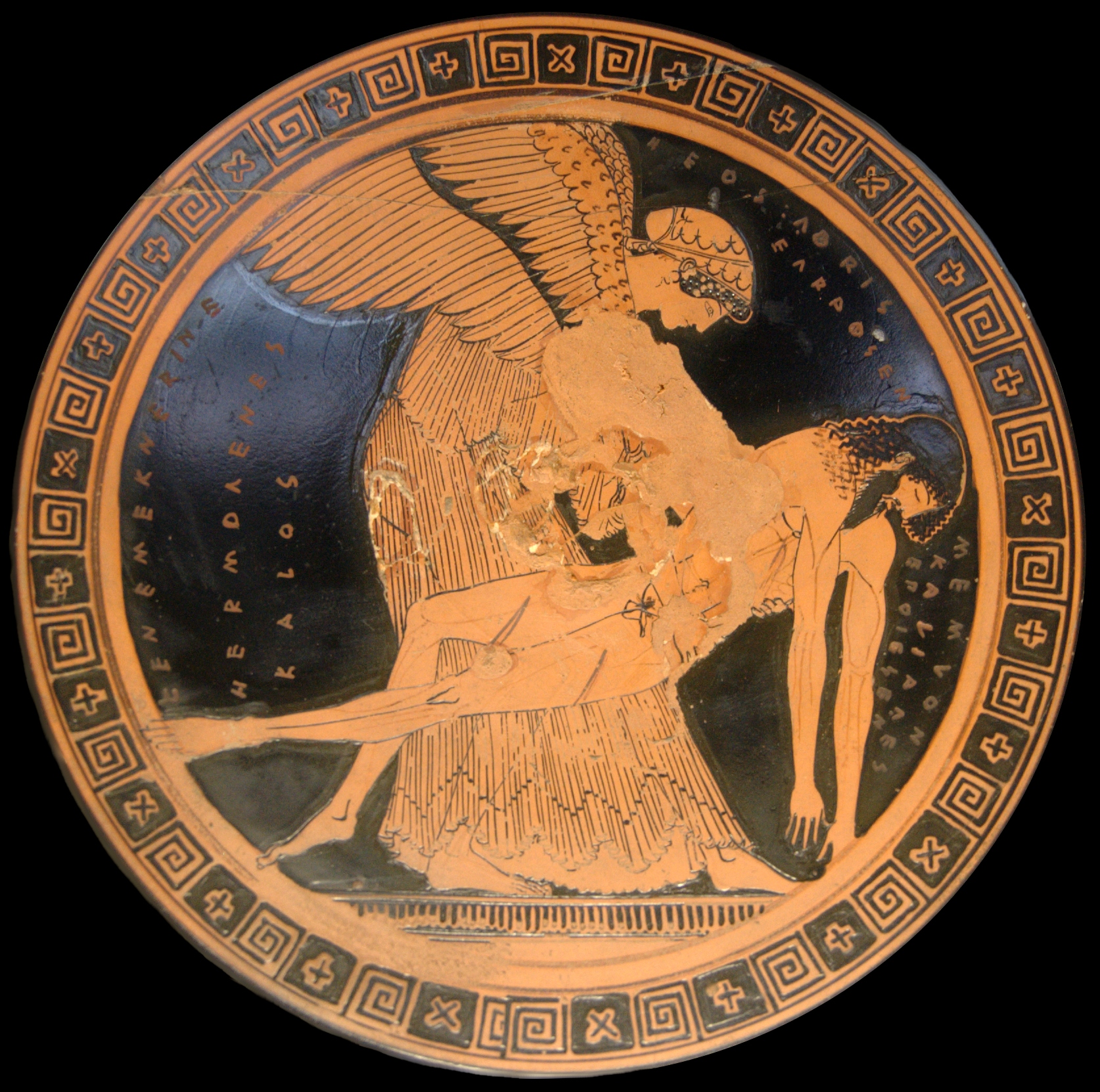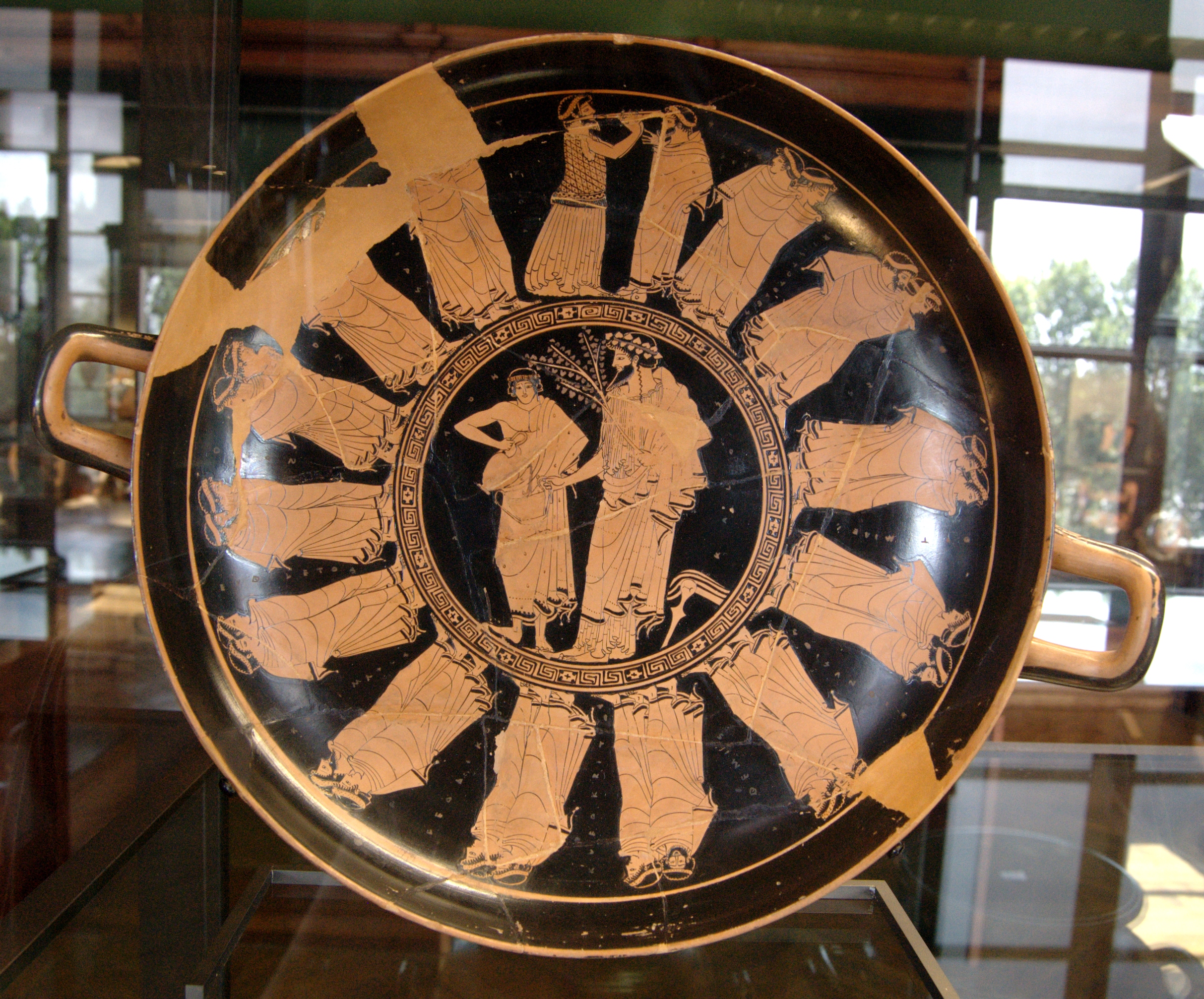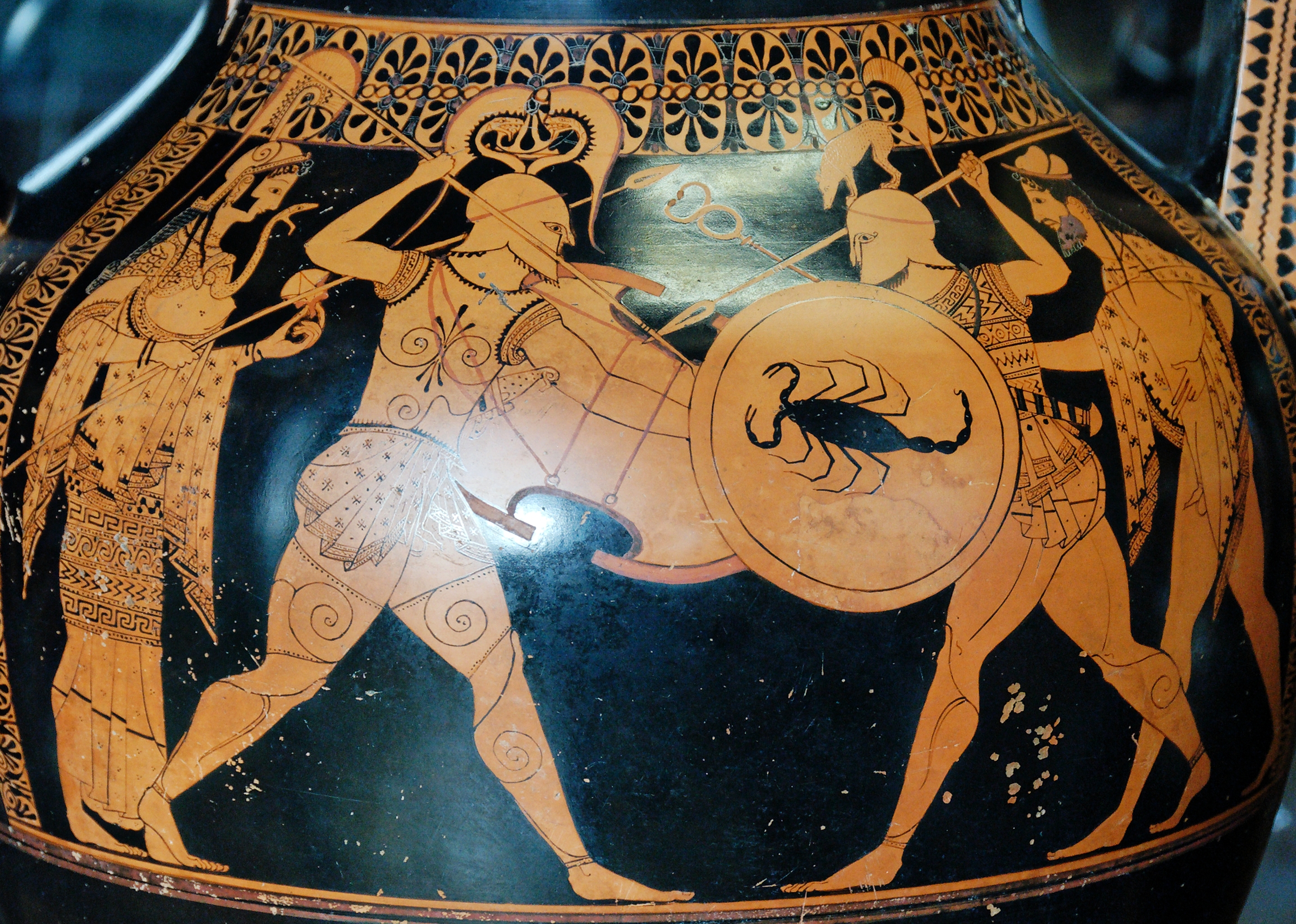|
Eucharides Painter
Eucharides Painter ( grc-gre, Εὐχαρίδης) is the common nickname of an ancient Greek artist who decorated but did not sign Attic vases. Neither his real name, nor the dates of his birth and death are known. Presumably this artist was a pupil of the Nikoxenos Painter. The name was introduced in 1911 by John Beazley, a classical historian at the University of Oxford, who had a special interest in Attic vases. Through close examination of stylistic details, Beazley and other scholars recognized pieces painted by the same artist. In this case, the nickname appreciates the anonymous painter's repeated use of kalos inscriptions praising the beauty of a named young boy. A vase with the inscription ΚΑΛΟΣ ΕΥΧΑΡΙΔΕΣ ("kalos Eucharides", i.e. Eucharides is beautiful) became the source of the artist's name. The Eucharides Painter was working in Athens in the years from about 500 BC to 470 BC. At this time the technique of vase painting switched from black-figure to ... [...More Info...] [...Related Items...] OR: [Wikipedia] [Google] [Baidu] |
Ganymede (mythology)
In Greek mythology, Ganymede () or Ganymedes (; Ancient Greek: Γανυμήδης ''Ganymēdēs'') is a divine hero whose homeland was Troy. Homer describes Ganymede as the most beautiful of mortals and tells the story of how he was abducted by the gods to serve as Zeus's cup-bearer in Olympus. The myth was a model for the Greek social custom of ''paiderastía'', the romantic relationship between an adult male and an adolescent male. The Latin form of the name was Catamitus (and also "Ganymedes"), from which the English word ''catamite'' is derived. According to Plato's Laws, the Cretans were regularly accused of inventing the myth because they wanted to justify their "unnatural pleasures". Family In Greek Mythology, Ganymede is the son of Tros of Dardania, whose name "Troy" is supposedly derived from, either by his wife Callirrhoe, daughter of the river god Scamander, or Acallaris, daughter of Eumedes.Dionysius of Halicarnassus''Antiquitates Romanae'' 1.62.2/ref> Depe ... [...More Info...] [...Related Items...] OR: [Wikipedia] [Google] [Baidu] |
Nikoxenos Painter
The Nikoxenos Painter ( grc-gre, Νικόξενος) was an Attic vase painter who worked in both the black-figure and red-figure styles. He was active in the end of the sixth and the beginning of the fifth centuries BC. His real name is not known. He was one of the few painters to work, apparently by his own choice, in both major styles. He painted black-figure amphorae and '' pelikai'' resembling the work of the Leagros Group. His ''hydria'' and '' kalpidai'' with continuous profile were already in the tradition of the new style. His black-figure work is considered better than his red-figure. The Eucharides Painter was his pupil; according to some theories they were actually identical. Bibliography * John Beazley Sir John Davidson Beazley, (; 13 September 1885 – 6 May 1970) was a British classical archaeologist and art historian, known for his classification of Attic vases by artistic style. He was Professor of Classical Archaeology and Art at the Un ...: ''Attic B ... [...More Info...] [...Related Items...] OR: [Wikipedia] [Google] [Baidu] |
John Beazley
Sir John Davidson Beazley, (; 13 September 1885 – 6 May 1970) was a British classical archaeologist and art historian, known for his classification of Attic vases by artistic style. He was Professor of Classical Archaeology and Art at the University of Oxford from 1925 to 1956. Early life Beazley was born in Glasgow, Scotland on 13 September 1885, to Mark John Murray Beazley (died 1940) and Mary Catherine Beazley née Davidson (died 1918). He was educated at King Edward VI School, Southampton and Christ's Hospital, Sussex. He then attended Balliol College, Oxford where he read Literae Humaniores: he received firsts in both Mods and Greats. He graduated with a Bachelor of Arts (BA) degree in 1907. While at Oxford he became a close friend of the poet James Elroy Flecker. Academic career After graduating, Beazley spent time at the British School at Athens. He then returned to University of Oxford as a student (equivalent to fellow) and tutor in Classics at Christ Church. ... [...More Info...] [...Related Items...] OR: [Wikipedia] [Google] [Baidu] |
University Of Oxford
, mottoeng = The Lord is my light , established = , endowment = £6.1 billion (including colleges) (2019) , budget = £2.145 billion (2019–20) , chancellor = The Lord Patten of Barnes , vice_chancellor = Louise Richardson , students = 24,515 (2019) , undergrad = 11,955 , postgrad = 12,010 , other = 541 (2017) , city = Oxford , country = England , coordinates = , campus_type = University town , athletics_affiliations = Blue (university sport) , logo_size = 250px , website = , logo = University of Oxford.svg , colours = Oxford Blue , faculty = 6,995 (2020) , academic_affiliations = , The University of Oxford is a collegiate research university in Oxf ... [...More Info...] [...Related Items...] OR: [Wikipedia] [Google] [Baidu] |
Kalos Inscription
A ''kalos'' inscription (''καλός'') is a form of epigraph found on Attic vases and graffiti in antiquity, mainly during the Classical period from 550 to 450 BC. The word ''kalos'' (καλός) means "beautiful", and in the inscriptions it had an erotic connotation. Overview The ''kalos'' inscription is typically found on vessels used for a symposium. The scenes that accompany the inscription vary, and include athletic exercises and myths. Some inscriptions are generic, reading only "the boy is beautiful" (ὁ παῖς καλός). The inscription more often took the form of the beloved's name, in the nominative singular, followed by "kalos" (''X kalos'', i.e. "X is beautiful"). The beloved is most often a male youth, but a few times girls or women were spoken of as ''kalē'' (καλή). In one early cataloging of the inscriptions, among the individuals labeled as beautiful were 30 women and girls, and 528 youths. Male names outnumber female by more than twenty to one. At ... [...More Info...] [...Related Items...] OR: [Wikipedia] [Google] [Baidu] |
Black-figure Pottery
Black-figure pottery painting, also known as the black-figure style or black-figure ceramic ( grc, , }), is one of the styles of painting on antique Greek vases. It was especially common between the 7th and 5th centuries BCE, although there are specimens dating as late as the 2nd century BCE. Stylistically it can be distinguished from the preceding orientalizing period and the subsequent red-figure pottery style. Figures and ornaments were painted on the body of the vessel using shapes and colors reminiscent of silhouettes. Delicate contours were incised into the paint before firing, and details could be reinforced and highlighted with opaque colors, usually white and red. The principal centers for this style were initially the commercial hub Corinth, and later Athens. Other important production sites are known to have been in Laconia, Boeotia, eastern Greece, and Italy. Particularly in Italy individual styles developed which were at least in part intended for the Etruscan ... [...More Info...] [...Related Items...] OR: [Wikipedia] [Google] [Baidu] |
Red-figure Pottery
Red-figure vase painting is one of the most important styles of figural Greek vase painting. It developed in Athens around 520 BCE and remained in use until the late 3rd century BCE. It replaced the previously dominant style of black-figure vase painting within a few decades. Its modern name is based on the figural depictions in red color on a black background, in contrast to the preceding black-figure style with black figures on a red background. The most important areas of production, apart from Attica, were in Southern Italy. The style was also adopted in other parts of Greece. Etruria became an important center of production outside the Greek World. Attic red-figure vases were exported throughout Greece and beyond. For a long time, they dominated the market for fine ceramics. Few centers of pottery production could compete with Athens in terms of innovation, quality and production capacity. Of the red-figure vases produced in Athens alone, more than 40,000 specimens and fra ... [...More Info...] [...Related Items...] OR: [Wikipedia] [Google] [Baidu] |
Andokides Painter
Andokides was an ancient Athenian vase painter, active from approximately 530 to 515 B.C. His work is unsigned and his true name unknown. He was identified as a unique artistic personality through stylistic traits found in common among several paintings. This corpus was then attributed by John D. Beazley to the Andokides Painter, a name derived from the potter Andokides, whose signature appears on several of the vases bearing the painter's work. He is often credited with being the originator of the red-figure vase painting technique. To be sure, he is certainly one of the earliest painters to work in the style. In total, fourteen amphorae and two cups are attributed to his hand. Six of the amphorae are " bilingual", meaning they display both red-figure and black-figure scenes. Biography Several details regarding the artistic biography of the Andokides Painter have been suggested through connoisseurial studies of his work. As mentioned, he is widely thought to be the creator of ... [...More Info...] [...Related Items...] OR: [Wikipedia] [Google] [Baidu] |
Homer
Homer (; grc, Ὅμηρος , ''Hómēros'') (born ) was a Greek poet who is credited as the author of the ''Iliad'' and the ''Odyssey'', two epic poems that are foundational works of ancient Greek literature. Homer is considered one of the most revered and influential authors in history. Homer's ''Iliad'' centers on a quarrel between King Agamemnon and the warrior Achilles during the last year of the Trojan War. The ''Odyssey'' chronicles the ten-year journey of Odysseus, king of Ithaca, back to his home after the fall of Troy. The poems are in Homeric Greek, also known as Epic Greek, a literary language which shows a mixture of features of the Ionic and Aeolic dialects from different centuries; the predominant influence is Eastern Ionic. Most researchers believe that the poems were originally transmitted orally. Homer's epic poems shaped aspects of ancient Greek culture and education, fostering ideals of heroism, glory, and honor. To Plato, Homer was simply the one who ... [...More Info...] [...Related Items...] OR: [Wikipedia] [Google] [Baidu] |
Iliad
The ''Iliad'' (; grc, Ἰλιάς, Iliás, ; "a poem about Ilium") is one of two major ancient Greek epic poems attributed to Homer. It is one of the oldest extant works of literature still widely read by modern audiences. As with the ''Odyssey'', the poem is divided into 24 books and contains 15,693 lines in its most widely accepted version, and was written in dactylic hexameter. Set towards the end of the Trojan War, a ten-year siege of the city of Troy by a coalition of Mycenaean Greek states, the poem depicts significant events in the siege's final weeks. In particular, it depicts a fierce quarrel between King Agamemnon and a celebrated warrior, Achilles. It is a central part of the Epic Cycle. The ''Iliad'' is often regarded as the first substantial piece of European literature. The ''Iliad'', and the ''Odyssey'', were likely written down in Homeric Greek, a literary amalgam of Ionic Greek and other dialects, probably around the late 8th or early 7th century BC. Homer's ... [...More Info...] [...Related Items...] OR: [Wikipedia] [Google] [Baidu] |
5th-century BC Athenians
The 5th century is the time period from 401 ( CDI) through 500 ( D) ''Anno Domini'' (AD) or Common Era (CE) in the Julian calendar. The 5th century is noted for being a period of migration and political instability throughout Eurasia. It saw the collapse of the Western Roman Empire, which came to an end in 476 AD. This empire had been ruled by a succession of weak emperors, with the real political might being increasingly concentrated among military leaders. Internal instability allowed a Visigoth army to reach and ransack Rome in 410. Some recovery took place during the following decades, but the Western Empire received another serious blow when a second foreign group, the Vandals, occupied Carthage, capital of an extremely important province in Africa. Attempts to retake the province were interrupted by the invasion of the Huns under Attila. After Attila's defeat, both Eastern and Western empires joined forces for a final assault on Vandal North Africa, but this campaign was ... [...More Info...] [...Related Items...] OR: [Wikipedia] [Google] [Baidu] |







_-_Homer_and_his_Guide_(1874).jpg)
